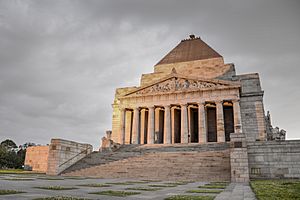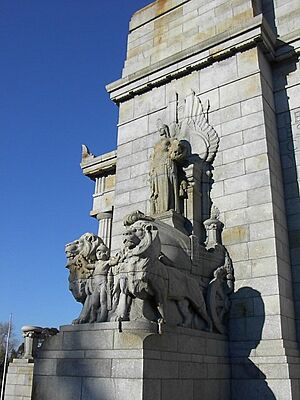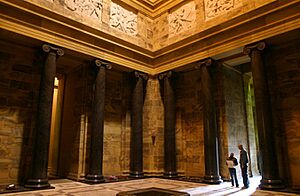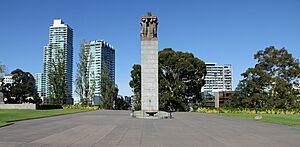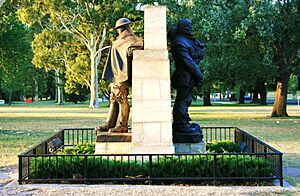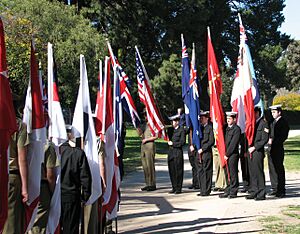Shrine of Remembrance facts for kids
The Shrine of Remembrance is a special war memorial in Melbourne, Victoria, Australia. It stands in Kings Domain on St Kilda Road. This important place was first built to honor the brave men and women from Victoria who served in World War I. Today, it remembers all Australians who have served in any war.
The Shrine is where people gather every year for Anzac Day (April 25) and Remembrance Day (November 11). It is one of the biggest war memorials in Australia. Two architects, Phillip Hudson and James Wardrop, designed the Shrine. Both of them were veterans of World War I.
The building looks like ancient Greek and Roman temples. It was inspired by the Tomb of Mausolus and the Parthenon in Athens, Greece. The top of the roof looks like the Choragic Monument of Lysicrates.
The Shrine is made from Tynong granite. Inside, there is a special marble Stone of Remembrance. On it are the words "Greater love hath no man." This quote comes from the Bible (John 15:13). Every year on November 11 at 11 a.m., a ray of sunlight shines through the roof. It lights up the word "Love" on the stone.
Underneath the main area is the crypt. Here you can see a bronze statue of a soldier father and son. There are also lists of every unit from the First Australian Imperial Force.
Contents
Building the Shrine of Remembrance
The idea for a war memorial in Melbourne started in 1918, right after World War I ended. In the early 1920s, a committee suggested building a large memorial. They wanted it to be easy to see from the city center.
Designing the Memorial
In 1922, a competition was held to find the best design. Many people sent in their ideas. Phillip Hudson and James Wardrop, two architects who had fought in the war, won the competition in 1923.
Debates and Delays
Not everyone liked the winning design. Some people, like newspaper editor Keith Murdoch, thought it was too big and expensive. They called it a "tomb of gloom." They thought the money should be used for things like a hospital instead. Some churches also didn't like it because it didn't have a cross.
Because of these debates, building the Shrine was delayed. For the 1926 Anzac Day march, a temporary memorial was put up. This led to a new idea: building a permanent memorial in a large "ANZAC Square." This plan was supported by many, including the Returned Soldiers League (RSL).
Support for the Shrine
However, General Sir John Monash, a famous Australian commander, strongly supported the original Shrine design. In 1927, he gave a powerful speech on the eve of Anzac Day. His speech helped gather a lot of public support for the Shrine.
With this new support, the government decided to go ahead with the Shrine. They also decided not to include a "Tomb of the Unknown Soldier" at the Shrine. An Australian Unknown Soldier was later buried at the Australian War Memorial in 1993.
Construction and Opening
The first stone for the Shrine was laid on November 11, 1927. Most of the money for the Shrine came from public donations. General Monash, who was also an engineer, helped manage the building work.
The Shrine was finished in September 1934. It was officially opened on November 11, 1934, by the Duke of Gloucester. Over 300,000 people came to watch, which was a huge crowd for Melbourne at the time. During World War II, the Shrine was even used as an air raid shelter.
Remembering Later Wars
After World War II, new parts were added to the Shrine to remember those who died in that war.
World War II Memorials
These additions included the World War II Forecourt, a large stone area in front of the Shrine. The Eternal Flame, a gas flame that burns all the time, was also added. There is also a tall cenotaph, which is a memorial stone, for World War II. Queen Elizabeth II dedicated these new parts in 1954.
Later wars, like the Korean War and the Vietnam War, are also remembered with special inscriptions. In 1985, the Remembrance Garden was added to honor those who served in conflicts after World War II.
Protests at the Shrine
During the Vietnam War, some people protested against the war at the Shrine during Anzac Day services. In 1971, the word "PEACE!" was painted on the Shrine's pillars.
In 2021, during a time of public health restrictions, a large group of people gathered at the Shrine to protest. Many people, including RSL Victoria, said that using the Shrine for protests was disrespectful to its sacred purpose. Police officers eventually moved the demonstrators away.
Inside and Outside the Shrine
The Shrine is built with materials from Australia. The main stone is granodiorite from Tynong. Inside, the walls use sandstone from Redesdale, and the black marble columns are from Buchan.
Outside the Shrine
The Shrine's design looks like ancient temples. It has large entrances on the north and south with tall columns. At the corners, there are four groups of statues by Paul Raphael Montford. These statues represent Peace, Justice, Patriotism, and Sacrifice.
Around the outside of the Shrine are 16 stone discs. These discs remember important battles where Australians fought, like the Landing at Anzac in Gallipoli.
Inside the Sanctuary
Inside the Shrine is the Sanctuary, a tall room with a high ceiling. It has 16 tall columns and carvings that show soldiers at work during World War I. In the middle is the Stone of Remembrance. It is set low in the floor, so visitors must bow their heads to read the words:
As mentioned, a ray of sunlight hits the word "LOVE" on this stone at 11 a.m. on November 11. This marks the exact time the war ended. A mirror helps direct the light now because of daylight saving.
On the western wall, there is another important message:
Around the Sanctuary, there is a passage called an ambulatory. It holds 42 bronze boxes with special handwritten books. These books list the names of every Victorian who served in World War I.
The Crypt and Visitor Centre
Beneath the Sanctuary is the Crypt. It has a bronze statue of a father and son, representing soldiers from both World Wars. The walls list every unit of the Australian Imperial Force.
The Shrine also has a Visitor Centre. It includes the Entrance Courtyard and the Garden Courtyard. The Gallery of Medals has a long wall displaying about 4,000 medals. Each medal represents 100 Victorians who served in wars. One special medal is the Victoria Cross awarded to Captain Robert Grieve.
World War II Forecourt and Remembrance Garden
The cenotaph in the World War II Forecourt is a tall stone pillar. It lists the names of defense forces and where they served. On top is a sculpture of six servicemen carrying a body draped in the Australian flag. This sculpture shows how the living honor the dead. The Eternal Flame nearby represents everlasting life.
The Remembrance Garden has a pool and a waterfall. A stone wall lists the names of conflicts and peacekeeping missions Australia has been part of since World War II.
Shrine Grounds and Other Memorials
The Shrine is located in a large park called Kings Domain. Over the years, many other war memorials have been added to this area.
Statues and Trees
You can find statues like "The Man with the Donkey," which remembers John Simpson Kirkpatrick. There is also a statue of General Monash. Many trees along the paths have plaques remembering different military units. An older memorial for Victorians who died in the Second Boer War is also nearby.
The Driver and Wipers Memorial remembers Australians lost in the fighting at Ypres (pronounced "Wipers" by soldiers). These bronze statues were made by Charles Sargeant Jagger.
A replica sculpture of Sergeant Simon Fraser rescuing a wounded soldier from the Battle of Fromelles was unveiled in 2008.
The Legacy Garden of Appreciation, shaped like a cross, was created in 1978. It has red Flanders Poppies that bloom in spring. The Women's Garden honors ex-servicewomen.
A special Lone Pine tree was planted in 1933. It grew from a seed from a pine cone brought back from Gallipoli. The original tree was removed in 2012 due to disease, but a "grandchild tree" was planted nearby in 2006.
Commemorative Services
The Shrine is the main place for war remembrance in Melbourne.
Anzac Day Services
On Anzac Day (April 25), several ceremonies take place. The Dawn Service is held early in the morning and attracts thousands of people. This is followed by an official wreath-laying service. Later, the Anzac Day March ends at the Shrine, followed by another service.
Remembrance Day
On Remembrance Day (November 11), leaders and community members gather to remember those who died or suffered in all wars. A minute of silence is observed at 11 a.m. as the ray of light shines on the Stone of Remembrance.
Throughout the year, other groups hold ceremonies and lay wreaths at the Shrine.
Managing the Shrine
The Shrine is looked after by the Shrine of Remembrance Trustees. These are ten people chosen by the government. They make sure the Shrine and its grounds are cared for and preserved.
Security for the Shrine is provided by the Shrine Guard. These guards often have a military background. They wear uniforms that look like an Australian Light Horseman from World War I.
See also
 In Spanish: Shrine of Remembrance para niños
In Spanish: Shrine of Remembrance para niños
- Australian and New Zealand Army Corps, also known as ANZAC, a name for Australian and New Zealand soldiers fighting together.
- Anzac Cove, a small bay in Turkey where Australian and New Zealand soldiers landed in 1915.
- Anzac Day, a public holiday on April 25 to remember the landing at Gallipoli.
- Anzac spirit, a term for the bravery and friendship of Australian and New Zealand soldiers.


